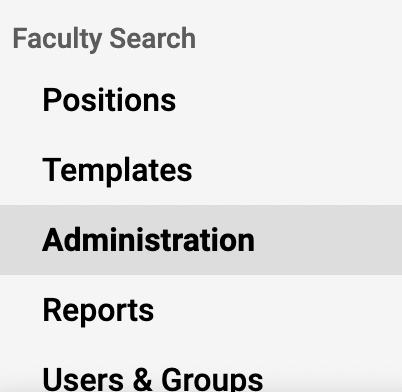Create and Manage Disposition Codes
Disposition codes are short, pre-defined explanations of why an applicant did not make it to the next step of the hiring process. Disposition codes help track and document committee decisions regarding each applicant, providing responsible documentation of the hiring process and mitigating liability by keeping a record of the stated reasons why each individual job applicant was removed from consideration. Administrators in Faculty Search (FS) can create disposition codes from the Administration page. Disposition codes created in the program are available to all units, and can be assigned to applicants by Administrators and Committee Managers. Disposition codes are internal only and candidates cannot see what disposition code they received or if a disposition code was applied to their application.
If disposition codes are turned off for an institution, or not yet created, the user will not see options to add disposition codes when working in the program.
About Disposition Codes
Disposition Codes vs. Application Statuses
Disposition codes are meant to work in conjunction with application statuses rather than replace them outright. Disposition codes are intended to document why a given applicant did not move any further in the process. In many situations, these fields will be reported on together to support reporting at the end of a search. Application statuses are meant to cover where a given applicant is in the committee’s process (such as Long List or Short List).
Using disposition codes for each applicant will help compliance reporting at the completion of a search. In many cases, it will help meet requirements for each applicant to have a valid code assigned to them. When used with a thoughtful final application status, disposition codes can become even more powerful tools for tracking applicants. Final application statuses such as Not Interviewed, Not Hired or Interviewed, Not Hired, can be used along with a set of disposition codes that helps explain the final decision.
A list of typical disposition codes includes:
- Salary requirements too high
- Availability date not compatible with department needs
- Less competitive based on the field of research
- Less competitive based on work history or experience
- Less competition based on education or training
- Wrong Degree
- Poor recommendations
- Less competitive based on information provided by references
Examples include:
| Final Application Status | Example Disposition Codes |
|---|---|
| Not Interviewed, Not Hired |
|
| Interviewed, Not Hired |
|
Set-Up
Navigation: Administration > Disposition Codes > Add
- Click Administration on the navigation bar.

- Click Disposition Codes from the navigation bar on the left-hand side.
Disposition Codes selected form navigation - Click the Add button at the top of the Disposition Codes page.
- Enter the Disposition Code.
The text limit is 100 characters.
- Click Save when finished. The disposition code will appear listed and can be used by all units as they consider applications for searches.
